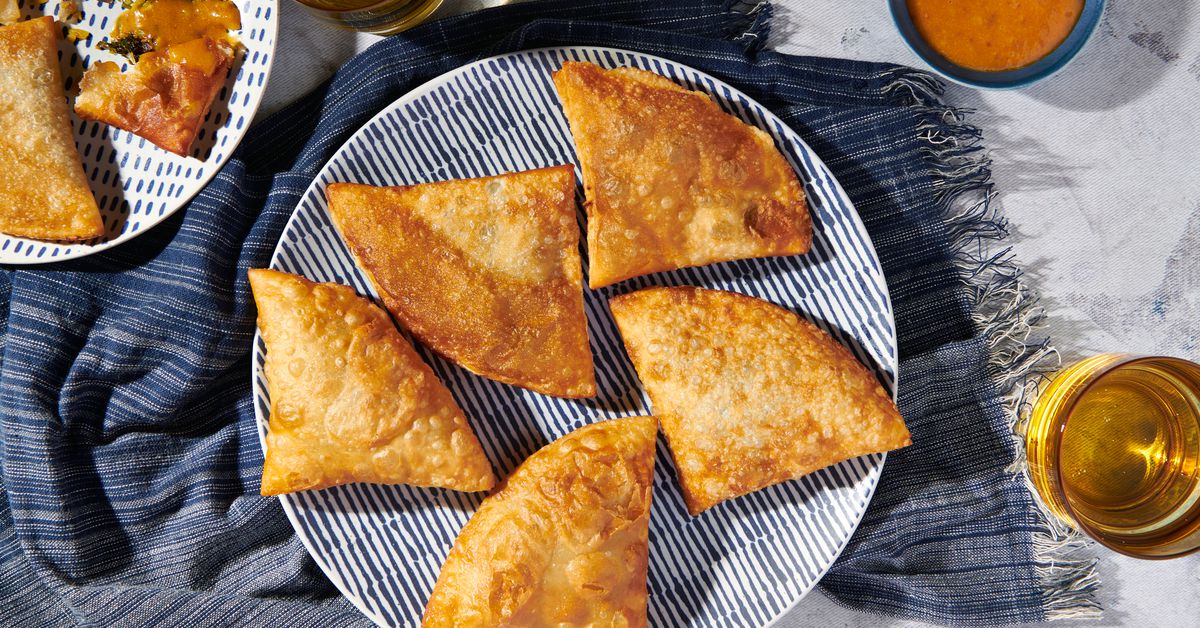
For chef Heena Patel, samosas have always been a sign of hospitality. “People would come without any announcement,” she said of growing up in Gujarat in the ‘80s. “And my mom would always have something warm for them.” Her mom’s samosas featured traditional Gujarati flavors — lots of potatoes, fennel, garlic and coriander — but Patel’s San Francisco restaurant, Besharam, is anything but traditional. Patel combines the flavors of Gujarat with ingredients she was drawn to in California, resulting in dishes like paratha with blue cheese and fruit compote, and pani puri with gin. Which is how we get to her kimchi samosa.
Patel was introduced to kimchi while working at the farmer’s market in San Francisco’s Ferry Building. “There was one local vegan, Aruna [Lee], who was the founder of Volcano Kimchi, and she used to have a stall right across from me,” Patel says. The two regularly exchanged food, and Patel came to love the spicy, fizzing bites of fermented kimchi. Eventually, she thought it might taste good in a samosa. “It’s a fried pastry dough filled with the freshness of the kimchi,” she says. “It’s a great combination.” She makes use of everything the kimchi has to offer: the squeezed, dried cabbage makes the filling, while the leftover juice is used for a paired chutney.
Along with kimchi, Patel’s recipe calls for many traditional Indian ingredients, like green mango, jaggery, and pauva, parboiled and flattened rice that cooks up quickly. You can find pauva at many South Asian markets, but Patel says you could also substitute chopped, dried rice noodles.
Perhaps the most surprising ingredient in the samosa, and a sign of Patel’s varied influences, is the flour tortillas she uses in place of samosa wrappers. Patel figured out the substitution while packing her kids’ lunches — “having this ready-made version that I [could] wrap quickly and give them something fresh, that’s the kind of trick I learned with my young family,” she says. It’s also the kind of trick that means you can have these ready any time company stops by. So it’s a little traditional after all.
Kimchi Samosa Recipe
Makes 6
Ingredients:
For the funky mango chutney:
3 tablespoons kimchi brine
1 cup finely chopped green mango
1 tablespoon jeera (whole cumin seeds)
½ cup soft jaggery or brown sugar
2 tablespoons lime juice
1 teaspoon sea salt
2 tablespoons canola oil
For the samosas:
1 cup of your favorite local Napa cabbage kimchi
2 tablespoons canola oil
1 cup finely chopped red onion
1 tablespoon minced garlic
¼ teaspoon sugar
1 teaspoon finely chopped serrano chile
2 cups finely chopped cabbage
8 finely chopped green onions
1 cup + 2 tablespoons finely chopped cilantro
1 teaspoon lime juice
1 cup uncooked pauva (flattened rice)
Salt, to taste
3 to 4 tablespoons water
4 tablespoons flour
10 (8 to 9-inch) raw uncooked flour tortillas (such as Tortillaland Tortillas)
½ gallon canola oil
Instructions:
Step 1: First, make the chutney: Put all the ingredients in a blender. Puree until smooth.
Step 2: Take a clean terra cloth and squeeze all the water out of the kimchi. Reserve the kimchi liquid for the chutney.
Step 3: Heat the oil in a medium-sized pot over medium-high heat. Add the chopped red onion, garlic, sugar and chili and saute for a few minutes until starting to lightly brown. Add cabbage, kimchi, green onion, cilantro, and lime juice, continuing to saute for 2 to 3 minutes. The cabbage should feel limp, but should not be releasing water. Stir in the pauva and then add salt to taste.
Step 4: Turn off the heat and transfer the mixture to a sheet pan to cool. Leave for 25 to 30 minutes. The mixture should look dry.
Step 5: In a mixing bowl, combine the water and to make a smooth paste.
Step 6: Take one tortilla and cut it in half. Bring the two corners together so they meet in the center and overlap. Apply the flour paste to secure the corners and create a triangular pocket. Put 2 tablespoons of the kimchi filling into the pocket, making sure that all the trapped air is released. Apply the flour paste to the open side and press down firmly to secure. Lay the prepared samosa on a lined sheet pan. Repeat with the rest of the samosas.
Step 7: Heat the remaining oil in a pot with a heavy base. Bring the temperature of the oil to 375 degrees. It’s important to have enough oil in the pot for the samosas to float; they shouldn’t touch the bottom.
Step 8: Fry the samosas in batches until they’re deep golden in color, about 3 minutes per side. Remove them from the oil with the help of a sieve or slotted spoon and transfer them to a tray lined with a thick paper towel. Serve hot with the funky mango chutney.
Dina Ávila is a photographer in Portland, Oregon.
Recipe tested by Ivy Manning
